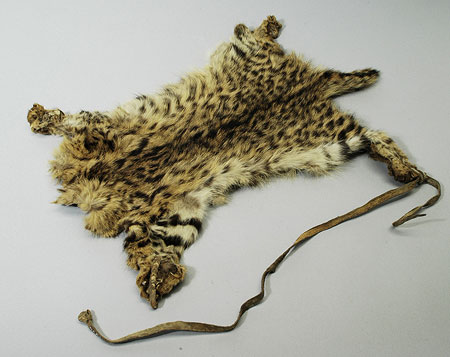Accession Number:
1936.10.65
Country:
Sudan
Region:
[Southern Sudan]
Cultural Group:
Anywaa [Anuak]
Date Made:
By 1936
Materials:
Cat Skin Animal , Cat Claw Animal , Animal Hide Skin
Process:
Perforated , Plaited , Tied , Knotted
Dimensions:
L = 500, W = 400 (front legs), 217 (across centre), 450 (back legs); hide strip extended L = 715, W = 8.2, th = 1 mm [RTS 15/2/2005].
Weight:
86.7 g
Local Name:
okworo
Other Owners:
Presumably collected by Evans-Pritchard during his period of fieldwork amongst the Anuak between early March and May 1935 [RTS 18/6/2004].
Field Collector:
Edward Evan Evans-Pritchard
PRM Source:
Edward Evan Evans-Pritchard
Acquired:
Donated 1936
Collected Date:
March - May 1935
Description:
Garment made from the skin of a wildcat.
This has been cut to retain the basic shape of the animal, including the neck, complete length of the tail, and all 4 legs including the paws with their claws intact.
The inside surface has been scraped down and is quite soft and still flexible; this is currently a muddy brown colour with yellow visible in patches (Pantone 7509C).
The outer surface is covered with soft cat fur, consisting of a light yellowish buff background (Pantone 7401C) with darker brown or black spots along the flanks (Pantone Black 6C), becoming more linear along the spine, and forming short banding around the legs and tail.
The fur is lighter running along the edges of either flank.
This patterning is typical of the genet.
One of the front legs has a hole through the centre of the paw; it is not clear if this is natural or deliberate.
The other front leg has been fitted with a short loop, made from 2 narrow strips of animal hide, pierced along their lengths and interwoven with one another to form a solid plaited length that is fastened to the skin body, leaving a herringbone design visible on the outer face, then opening out at the top end to form a loop of double hide thickness.
One of the lower leg flaps appears to be unmodified, but the other has been fitted with a second hide strip, similarly plaited onto the skin body, and looped at the top to extend just beyond the edge of the cat skin.
Another strip has been threaded through this loop, with a knot just below to hold it in place; this has a long body, knotted part way along its length and again at the end, producing a strap that could be used in conjunction with the hole or loop on the other end of the object to fasten it in place over the shoulder.
This strap is light brown, with some buff surface hairs on the outer face (Pantone 7506C).
The skin is complete, with a few holes worn through the body.
It has a weight of 86.7 grams, and is 500 mm long, 400 mm wide at the front legs, 217 mm wide across the centre and 450 mm wide across the back legs, on the skin side only.
The hide strip has a width of 8.2 mm and is 1 mm thick, with an extended length of 715 mm.
Collected by E.E. Evans-Pritchard during his fieldwork amongst the Anuak, which took place between early March and May 1935 (E.E. Evans-Pritchard, 1940, The Political System of the Anuak of the Anglo-Egyptian Sudan, p. 3).
This skin was worn over the left shoulder by men during dances, and is known as okworo.
Rachael Sparks 25/9/2005.
Collected by E.E. Evans-Pritchard during his fieldwork amongst the Anuak, which took place between early March and May 1935 (E.E. Evans-Pritchard, 1940, The Political System of the Anuak of the Anglo-Egyptian Sudan, p. 3).
This skin was worn over the left shoulder by men during dances, and is known as okworo.
Rachael Sparks 25/9/2005.
Primary Documentation:
Accession Book Entry
[p.
410] - 1936 [insert] 10 [end insert] E.
EVANS-PRITCHARD, M.A., Exeter College, Oxford.
- Specimens collected by himself in the EASTERN SUDAN, while travelling with a Grant from the
Rockefeller
Leverhulme Trustees, viz: [p.
416] [insert] 65 [end insert] - Wild-cat’s skin,
okworo
, worn over the left shoulder by men at dances.
ANUAK.
Card Catalogue Entry - There is no further information on the catalogue card [RTS 30/1/2004].
Pitt Rivers Museum label - okworo , wild-cat's [sic] worn over the left shoulder by men at dances. ANUAK, E. SUDAN. d.d. E. Evans-Pritchard, 1936 [rectangular metal-edged tag, tied to object; RTS 15/2/2005].
Card Catalogue Entry - There is no further information on the catalogue card [RTS 30/1/2004].
Pitt Rivers Museum label - okworo , wild-cat's [sic] worn over the left shoulder by men at dances. ANUAK, E. SUDAN. d.d. E. Evans-Pritchard, 1936 [rectangular metal-edged tag, tied to object; RTS 15/2/2005].






